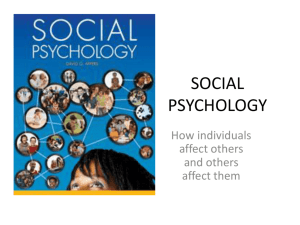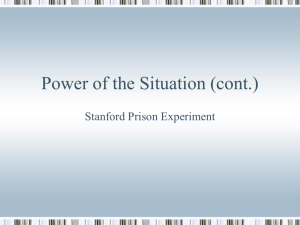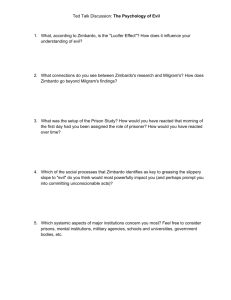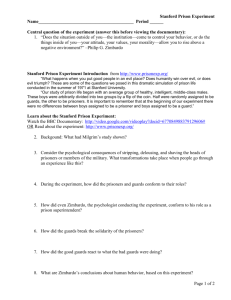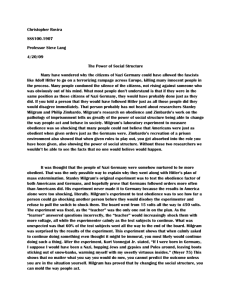THE STANFORD PRISON EXPERIMENT
advertisement
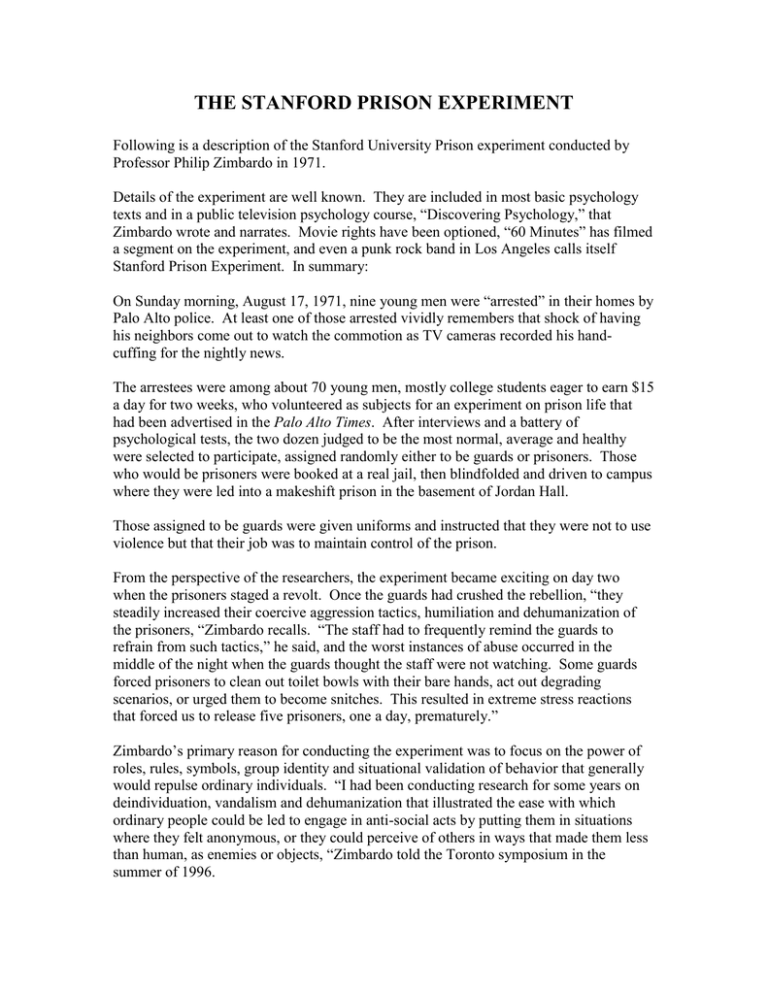
THE STANFORD PRISON EXPERIMENT Following is a description of the Stanford University Prison experiment conducted by Professor Philip Zimbardo in 1971. Details of the experiment are well known. They are included in most basic psychology texts and in a public television psychology course, “Discovering Psychology,” that Zimbardo wrote and narrates. Movie rights have been optioned, “60 Minutes” has filmed a segment on the experiment, and even a punk rock band in Los Angeles calls itself Stanford Prison Experiment. In summary: On Sunday morning, August 17, 1971, nine young men were “arrested” in their homes by Palo Alto police. At least one of those arrested vividly remembers that shock of having his neighbors come out to watch the commotion as TV cameras recorded his handcuffing for the nightly news. The arrestees were among about 70 young men, mostly college students eager to earn $15 a day for two weeks, who volunteered as subjects for an experiment on prison life that had been advertised in the Palo Alto Times. After interviews and a battery of psychological tests, the two dozen judged to be the most normal, average and healthy were selected to participate, assigned randomly either to be guards or prisoners. Those who would be prisoners were booked at a real jail, then blindfolded and driven to campus where they were led into a makeshift prison in the basement of Jordan Hall. Those assigned to be guards were given uniforms and instructed that they were not to use violence but that their job was to maintain control of the prison. From the perspective of the researchers, the experiment became exciting on day two when the prisoners staged a revolt. Once the guards had crushed the rebellion, “they steadily increased their coercive aggression tactics, humiliation and dehumanization of the prisoners, “Zimbardo recalls. “The staff had to frequently remind the guards to refrain from such tactics,” he said, and the worst instances of abuse occurred in the middle of the night when the guards thought the staff were not watching. Some guards forced prisoners to clean out toilet bowls with their bare hands, act out degrading scenarios, or urged them to become snitches. This resulted in extreme stress reactions that forced us to release five prisoners, one a day, prematurely.” Zimbardo’s primary reason for conducting the experiment was to focus on the power of roles, rules, symbols, group identity and situational validation of behavior that generally would repulse ordinary individuals. “I had been conducting research for some years on deindividuation, vandalism and dehumanization that illustrated the ease with which ordinary people could be led to engage in anti-social acts by putting them in situations where they felt anonymous, or they could perceive of others in ways that made them less than human, as enemies or objects, “Zimbardo told the Toronto symposium in the summer of 1996. 2 “I wondered, along with my research associates Craig Haney, Curtis Banks and Carlo Prescott, what would happen if we aggregated all of these processes, making some subjects feel deindividuated, others dehumanized within an anonymous environment in the same experimental setting, and where we could carefully document the process over time.” Jekyll and Hyde Experience Christina Maslach walked into the mock prison on the evening of the fifth day. Having just received her doctorate from Stanford and starting an assistant professorship at Berkeley, she had agreed to do subject interviews the next day and had come down the night before to familiarize herself with the experiment. She was the then girlfriend of Professor Zimbardo and later became his wife. At first, she said, she found it “dull and boring.” “I looked at the prison yard from the point of view of the video camera (that had been set up to monitor it) and there was not much happening. So I went around to the other end of the hall where some guards were waiting to start their next shift.” There, she had a pleasant conversation with a “charming, funny, smart” young man waiting to start his guard shift. Other researchers had told her there was a particularly sadistic guard, whom both prisoners and other guards had nicknamed John Wayne. Later, when she looked at the monitor of the prison yard again, she asked someone to point out John Wayne and was shocked to discover it was the young man she had talked with earlier. “This man had been transformed. He was talking in a different accent, a Southern accent, which I hadn’t recalled at all. He moved differently and the way he talked was different, not just in the accent, but in the way he was interacting with the prisoners. It was like (seeing) Jekyll and Hyde…It really took my breath away.” Several prisoners engaged in a debate with John Wayne, she said, in which they accused him of enjoying his job. He said that he wasn’t really like that, he was just playing a role. One prisoner challenged this, Maslach said, noting that the guard had tripped him earlier when he was taking him down the hall to the bathroom. No researchers were around to see the act, the prisoner said, which indicated to him that the act reflected the guard’s true disposition. John Wayne disagreed, saying that if he let up, the role wouldn’t remain powerful. Later that evening, Maslach said, she suddenly got sick to her stomach while watching guards taking the prisoners with paper bags over their heads to the bathroom before their bedtime. Her fellow researchers teased her about it. After leaving the prison with Zimbardo, she said, he asked her what she thought of it. “I think he expected some sort of great intellectual discussion about what was going on. 3 Instead, I started to have this incredible emotional outburst. I started to scream, I started to yell, “I think it is terrible what you are doing to those boys!” I cried. We had a fight, you wouldn’t believe, and I was beginning to think, wait a minute, I don’t know this guy. I really don’t and I’m getting involved with him?” Zimbardo was shocked by her reaction and upset, she said, but eventually that night, “he acknowledged what I was saying and realized what had happened to him and to other people in the study. At that point he decided to call the experiment to a halt.” Says Zimbardo: “She challenged us to examine the madness she observed, that we had created and had to take responsibility for.” Research Ethics And what about research institutions? Zimbardo still has mixed emotions about the ethics of his experiment. His experiment has been criticized by some social scientists, as was the obedience experiment of his high school classmate Stanley Milgram, for its treatment of human research subjects. In Milgram’s 1965 experiment, the subjects were led to believe that they were delivering even more powerful electric shocks to a stranger, on the orders of a white-coated researcher. Most were distressed by the situation, but two-thirds delivered the highest level of shock labeled “danger-severe shock.” Like some of “Zimbardo’s guard subjects, some of Milgram’s were anguished afterward by the revelation of their dark potential. When asked about the ethics of such research for a 1976 magazine profile, Zimbardo said that “the ethical point is legitimate insofar as who are you, as an experimenter, to give a person that kind of information about oneself. But my feeling is that that’s the most valuable kind of information that you can have and that certainly a society needs it.” 1. What relevance does this experiment have in our study of the Holocaust? 2. What do we learn from the behavior of the guard nicknamed “John Wayne?”

